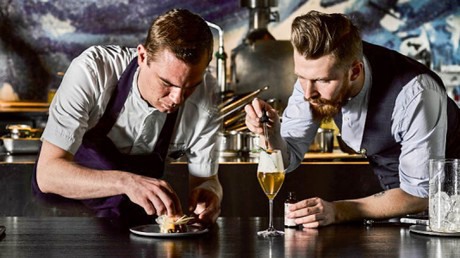Visual sensation, the continued growth of technology, and veganism are just three of the international culinary trends. These trends can also be found in many Dutch restaurants. These trends are reflected in The Dining Out Trends Report 2019. This report contains the global trends emerging in the restaurant industry. It is compiled by IENS in collaboration with the international market research firm, Doxa. The IENS is a Dutch platform for finding and reserving tables at restaurants in Europe.
1. Visual sensation
In recent years, Instagram and other apps used to share photos on the internet have brought about a true revolution in the hospitality industry. Some restaurants even create special dishes and cocktails to maximize their impact op social media. Instagram Stories, Facebook Live, and YouTube have further extended this trend. These sites show what works well, using visual content on their platforms.
Restaurants, in particular those in the fast service industry, are doing everything in their power to surprise their customers. Who can forget images of Happy Happy Joy Joy rainbow-colored Bao Buns or Restaurant Fiko's gold-coated pizzas on Instagram? Both these establishments are in the Dutch city of Amsterdam. This development encourages the sharing of a culinary experience via social media.
 Happy Happy Joy Joy
Happy Happy Joy Joy
2. Continued growth of technology
Ninety-five percent of restaurant owners in the United States of America admit that technology has significantly improved the efficiency of their restaurants (source: Toast). From serving meals with drones to paying on apps - restaurants are integrating more and more technological solutions. In the Netherlands, we see, in particular, the increased use of tablets to take orders.
In some restaurants, tech even becomes part of the dining experience. For example, Robot.He is a robot in a fish restaurant in Shanghai, China. This restaurant is in the Alibaba supermarket. This robot does practically all the staff's 'work'. Its software system allows its to guide customers to their places and take orders and payments. This is done via an app, using QR codes supplied by the diners.
These technological developments range from drone waiters to hyperrealistic augmented reality menus. In this context, restaurants are trying to find the correct balance between efficiency brought about by innovation and human contact.
3. Dining based on DNA
Consumers are finding it increasingly important to know what they are eating and where their food comes from. This has led to the launching of apps that can help restaurant guests identify unknown ingredients.
BARCLAYCARD has developed a prototype of such an app. It allows guests to familiarize themselves with the ingredients listed in a particular menu. Vita Mojo is a chain of restaurants based in London. Here, meals are created that are tailored to each guest's personal genetic code. This is done in collaboration with DNAft, a Canadian DNA testing company.
4. Transparency and eco-friendliness
Diners are also increasingly demanding transparency when it comes to sourcing and the origin of foodstuffs. They also want to know about growth and processing methods. As a response to this, companies need to adopt a multifaceted approach. This approach must not only influence the service they provide to their customers but also the company's internal policies.
As a result, there will be more transparency in various areas. These include prices, remunerations, and company performance. There will be a greater emphasis on fair trade and diversity. There will also be more attention and communication regarding the restaurant's environmental impact.
Large chains are rolling out eco-initiatives with ever-increasing regularity. Small companies are finding environmentally-friendly solutions to fight food wastage. These solutions include restaurants that create menus with supermarket leftovers.
An example of this is the InStock restaurant and the BlueSpoon Bar the Andaz hotel. These places are both in Amsterdam. The bar transforms the restaurant's usable leftovers into cocktails. These are served at the hotel bar. Many restaurants have also banned plastic straws. They have done so in order to reduce plastic waste and pollution.
 The BlueSpoon bar in the Andaz Hotel
The BlueSpoon bar in the Andaz Hotel
5. Veganism
Eating a plant-based meal is increasingly influencing restaurants' entire policies. They are moving toward not only, not producing waste, but are finding ways to stimulate sustainability as well. The whole restaurant industry is increasingly introducing more vegetarian menus and wine packages. Contrary to popular belief, not all wine is produced in a plant-based manner. This shift is as a result of the rise in veganism.
This trend is also leading to new concepts in which veganism is combined with other cuisines. An example of this is the vegetarian Korean restaurant, saVeg in Calgary, Canada. This eatery was opened by the Canadian YouTube star, Cheap Lazy Vegan.
6. The experience of dining
In general, people - millennials in particular - would rather spend money on an experience rather than simply making a purchase. This development will further increase in 2019. Restaurants will be no exception. When choosing a restaurant, diners want to be inspired and surprised. They want more than just a good meal. They want an exciting gastronomic experience.
This leads to different new concepts - from a multi-sensory dining experience to permanent pop-up restaurants. In this way, new ideas are created. These include places such as cartoon-themed restaurants like the First Official Totoro-themed restaurant in Bangkok in Thailand. Here you can dine in the persona of a superhero. Then there is Dinner in Motion. This is a 360-degree restaurant in the Dutch city of Eindhoven. Diners here go on a culinary journey, through a sensory experience.
7. Superfood restaurants
Superfoods form part of many people's eating plans, even when dining in restaurants. During the first wave of this phenomenon, restaurants introduced uber-healthy ingredients into their recipes. In 2019, this will go one step further. Functional ingredients will be added to dishes.
These ingredients promote improvements to a person's body as well as their soul. Think of collagen for beauty and cannabis for relaxation. Then there is hibiscus tea for stress relief and blood pressure reduction. Holistic and chic healthy restaurants are new concepts that are following this trend.
